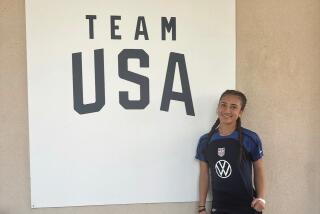Kids Take Fast Lane to Utah Olympics
- Share via
PARK CITY, Utah — While most kids are dabbling in peewee basketball or youth soccer, a few hardy young daredevils who dream of Olympic gold are careening down Utah’s mountains.
Each weekday beginner bobsledders, lugers, ski jumpers and aerial freestyle skiers test their mettle at the Utah Winter Sports Park, a venue for the 2002 Winter Games.
But these young athletes aren’t worried about 2002. They’re looking ahead to the 2006 games in Turin, Italy.
Children too young for drivers’ licenses race down the luge chute at 60 mph, clad in lead vests to increase their momentum.
Twelve-year-old Garon Thorne of Orem started training last summer and now tears down the track in a skintight racing suit sewn by his mother. No matter that on his last run, he crashed the whole way down the run.
“He’s fearless. They’re all fearless,” Shannon Thorne said as her son climbed into a truck for a lift up to the start to try to break his personal record--58.2 mph. Garon gave her an ear-to-ear smile and waved.
Olympic organizers have set up their program to involve youngsters in these offbeat winter sports with more in mind than future medals. They want to keep Utah’s new Olympic tracks and jumps popular long after the 2002 Winter Games.
“We’re trying to keep these venues alive and keep the sport growing in Utah. The Olympics are a one-shot deal,” said Bob Bills, director of the Sport to Sport program.
Bills has been traveling around the state recruiting kids who show promise in sports such as gymnastics, track and football, to see if they have promise in Olympic winter sports.
After the field is trimmed in training camps, the most promising beginners are offered the chance at more advanced training--often for free or nominal monthly fees.
On one of his scouting trips, Bills discovered Austin Cummings, then a 13-year-old gymnast with the Heber Hand Springers in Heber City.
Two years later, Cummings, now 15 and an aerial freestyle skier, is recovering from his first skiing injury, a separated bone in his shoulder.
Undaunted and wearing an arm brace covered with patches from sponsors, Cummings swears he’ll be back on the ramp in four weeks, this time starting work on double flips.
“He’s always been very, very energetic. A lot of people told me he was hyperactive, but I always said no, he’s just very active,” said his mother, Valorie Cummings. “I’d rather have him this way than sitting in a corner.”
Austin juggles aerial skiing with wrestling, gymnastics, downhill skiing and diving.
His mother remembers Austin’s first aerial camp.
“It was comical, and I thought there’s no way he could do it. He couldn’t ski and it was obvious,” she said.
Crashing is common, and injuries sometimes occur. Hours after witnessing a fellow ski jumper break his thigh, 12-year-old Chris Francis was packing his ski gear for a Junior Olympic Qualifier in Steamboat, Colo. Francis, a veteran of the sport, started jumping when he was just 5 years old.
He was unfazed by the injury to a 13-year-old teammate.
“It doesn’t worry me ‘cause I’ve seen it happen so much.” Anyway, Francis said, “He was on a smaller hill.”
With their high rates of speed and spectacular crashes, these sports seem dangerous--especially when they involve children.
But Matthew Terwillegar, program director of National Sports Foundation Ski Jumping and Nordic Combined, said there are more injuries on a soccer team than a ski-jumping team. After about 70,000 jumps since 1992, five kids in the program have had to go the hospital.
“The sport has such a bad rap,” Terwillegar said, recalling vivid footage of a ski-jumping accident that opened “ABC’s Wide World of Sports.” “Everyone looks at it as some type of daredevil sport. But there are more injuries in freestyle, more in luge.”
The recent crash involving the boy who broke his femur was the first time in three years that the ski-jumping program had to call in a medical helicopter.
“It looks spectacular, for sure, but it takes kids a long time to get to that level,” he said of ski jumping. “Kids could be doing worse things than sports.”
Compared to the nearby ski resorts that keep AirMed busy with dozens of calls a season, the medical helicopter probably will be called to the Utah Winter Sports Park two or three times a season, said Ken Matthews, chief flight nurse for AirMed, which operates out of the University of Utah Hospital in Salt Lake City.
“It’s just a little more of a controlled environment. The people there are better trained, and when they are there, they’re focused on their sport,” Matthews said.
And focused on possible gold medals for hometown kids.
“I would really like to medal in the Olympics. Or even just make it to the 2006 Olympics. No, if I go to the Olympics, I’m going to want to win. So I guess I want to win gold,” Cummings said.
Terwillegar also is watching his young athletes with an eye to the future.
“In 2006, I’m going to guarantee there’s going to be kids from here at the Olympics,” he said.
More to Read
Go beyond the scoreboard
Get the latest on L.A.'s teams in the daily Sports Report newsletter.
You may occasionally receive promotional content from the Los Angeles Times.






